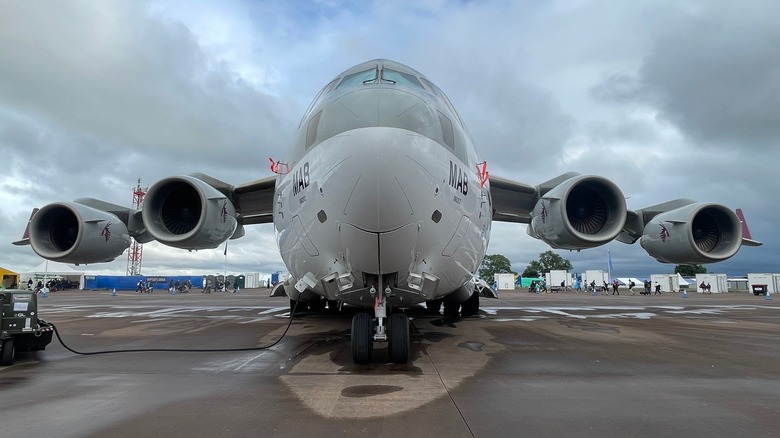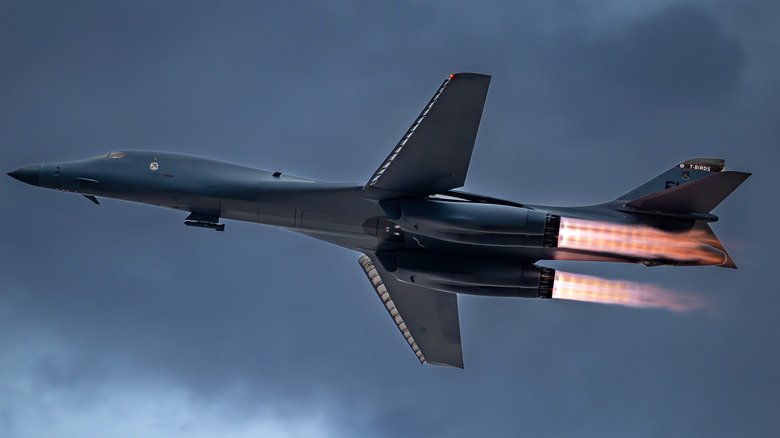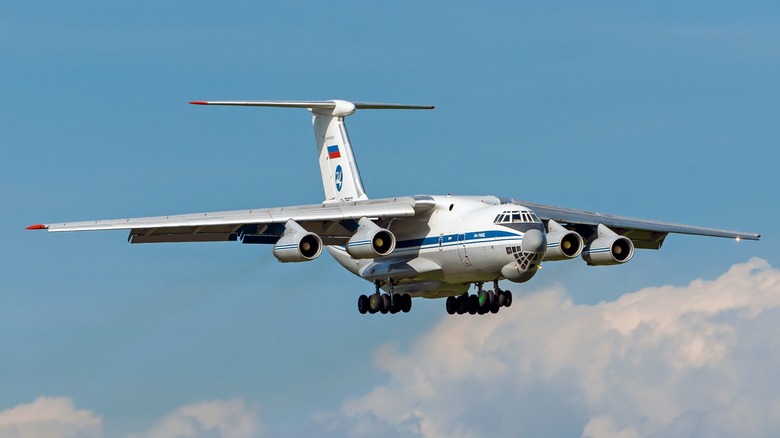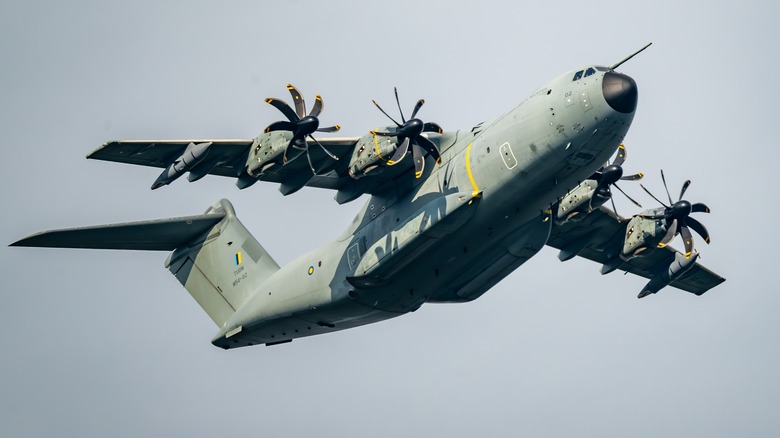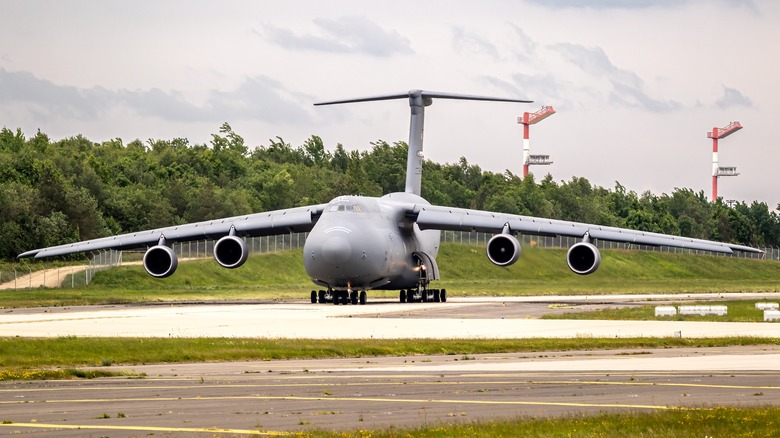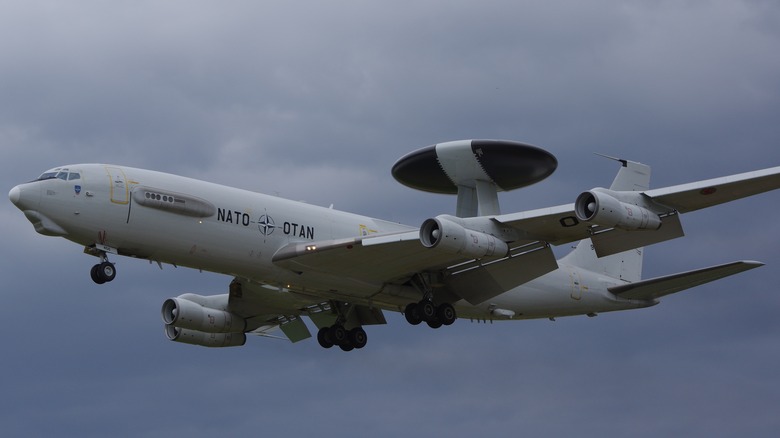5 Military Planes That Have Four Engines
The world's militaries have a plethora of planes in use, and most of them have one to two engines. That's true of older fighter jets like the Mirage F1, and it's true of the newest F-35 Lightning II as well. Of course, fighters are aircraft built for one to two occupants, and there are much larger planes out there. Transport aircraft and similar planes typically have two engines (twinjet). There are tons of those, but one configuration that doesn't get much attention is four-engine (quadjet) aircraft, and there are only a handful of these in use by the U.S. military.
As it happens, many of these quadjets fly for the United States Air Force, though not all of them. The aircraft that require four engines are large, and to move a massive object, you'd need a lot of energy. Four engines can certainly provide that, and for this reason, many four-engine aircraft used by the military are capable of carrying an immense amount of weight.
These types of aircraft typically carry cargo and payloads weighing dozens of tons, so a lot of power is required to move them around the planet. Quadjets fell out of fashion as jet technology advanced, so some of the huge aircraft built toward the late-20th century were twinjets. This left some legacy aircraft, including a strategic bomber, as the only quadjets in the military. While some have more — the B-52 Stratofortress has eight — these five quadjets still fly using all four jets.
Rockwell B-1 Lancer
The Rockwell B-1 Lander is the oldest of the United States' three strategic bombers. The U.S. Air Force has been flying the B-1 Lancer for over 40 years, as it was introduced in 1985. There's a reason the B-1 Lancer continues to operate, and it has to do with its payload capacity. The B-1 can carry a payload of 75,000 lbs., which is considerably more than the B-2 Spirit or B-21 Raider. To accomplish this, the B-1 is equipped with four General Electric F101-GE-102 turbofan engines with afterburners.
The F101 was built specifically for the B-1 program, having been introduced first in 1983. Each engine rates in the 30,000 lbs. thrust range, which is what makes the B-1's maximum speed of Mach 1.2 (921 mph) possible. The B-1's engines helped it attain a significant number of world records in speed, payload, and other categories. Its most recent records were made official in 2004 for an air show from the previous year.
While the B-1's payload capacity is immense, the aircraft itself weighs significantly more. The B-1's maximum takeoff weight is 477,000 lbs., which accounts for the plane, its potential cargo, and more. If the tank is topped off, the B-1's fuel capacity is 265,274 lbs., and it's all needed to keep those four F101 engines burning. The B-1's range is intercontinental, and it can be refueled in the air, so its engines can keep it airborne for as long as its pilots and crew can sustain.
Ilyushin Il-76 Candid
The Ilyushin Il-76 (NATO reporting name, "Candid") is a quadjet strategic airlifter first used by the Soviet Air Forces. The Il-76 was first introduced in 1974, and it remains in service more than 50 years later. The Il-76 was built to satisfy a specific need of the Russian Air Forces to transport payloads of 88,000 lbs. (40 tons) to remote areas within a target range of 3,100 miles. The Il-76 evolved from that requirement, and it proved itself capable of transporting the necessary weight in under six hours.
Ilyushin Il-76s have since been upgraded and modernized, with the latest model — the Il-76MD-90A — arriving in 2014. Whatever the version, the Il-76 is a multirole aircraft, and in addition to transport, they've been used as firebombers, command aircraft, and more. For power, the Il-76 uses four Soloviev D-30KL turbofan engines, each capable of delivering 26,500 lbf (pound force). These engines were designed specifically for the Il-76s, and they've continued providing power to the fleet decades after their introduction.
The aircraft's maximum weight is 418,878 lbs., nearly half of which is the weight of its fuel capacity. The Il-76 is one of the most successful aircraft of its kind, and it's used in both military and commercial applications throughout the world. Newer models are capable of reaching greater range, though the IL-76MF-100 uses four CFM56-5C turbofan engines, each capable of providing up to 34,000 lbf.
Airbus A400M Atlas
Modern aircraft predominantly use jet engines, but not always. The Airbus A400M is a quadjet that uses four eight-bladed propellers to make its way through the sky. The turboprop transport aircraft has been around since its introduction in 2013, and it's used by numerous European militaries including the German Air Force, Royal Air Force, Spanish Air Force, and many others. The purpose of the A400M's design was to approach the carrying capabilities between the American C-130 and C-17, and be able to use rough landing strips.
Airbus advertises the plane as being state-of-the-art and capable of operating as a frontline tanker; it can carry strategic loads and use rough airstrips to deliver cargo to tactical locations. The A400M can haul 81,600 lbs. (37 tons) of cargo, land and takeoff from unprepared airstrips, reach an altitude of 40,000 feet, has a max speed of Mach 0.72 (548 mph), has a radius of 5,500 miles, and it can transport 116 personnel, helicopters, vehicles, and much more.
To do this, the A400M is equipped with four Europrop TP400-D6 turboprop engines, each capable of delivering 11,000 horsepower. The TP400-D6 was developed for the Airbus A400M, and, according to Maria Giuseppina Motta, Program Director of Avio Aero. "The TP400 is the most powerful turboprop engine in the Western world and the most powerful in the world in the single propeller configuration." These engines pack a serious punch and deliver a great deal of power, enabling the A400M to meet its operational requirements.
Lockheed Martin C-5M Super Galaxy
The Lockheed C-5 Galaxy is one of the largest planes in the world, and it's considerably larger than the C-17 Globemaster III. Both aircraft carry massive amounts of cargo, but the C-5 is truly the monster of the two, as it's the largest operational military aircraft in the world. The C-5 entered the inventory in 1970, and it's been flying ever since. Its primary role is as a large military transport aircraft capable of carrying immense payloads over a distance of 5,500+ miles. The C-5 is not only the largest aircraft in the military; it's also the heaviest.
The C-5 can carry 281,001 lbs. of cargo, which is enough to theoretically transport two M1A2 Abrams Main Battle Tanks. With cargo and fuel at maximum capacity, a C-5 weighs a whopping 840,000 lbs., so it's truly a beast of a plane. To move that much weight, the C-5 is equipped with four F-138-GE100 General Electric Engines, each capable of delivering 51,250 lbf for a combined thrust of 205,000 lbs.
The F138 (CF6-80 is the civilian version) engine is the result of a re-engineered TF39 built specifically for the C-5 in 1969. The F138s are the latest in a long line of General Electric purpose-built engines equipped on the C-5M Super Galaxy, which is the modern variant operated by the U.S. Air Force as of 2014. This engine is the latest in a long line of legacy upgrades to the original C-5, extending the life of the transport aircraft until at least 2040.
Boeing E-3 Sentry
The Boeing E-3 Sentry is an airborne early warning and control (AEW&C) aircraft used primarily by members of NATO. The aircraft was developed in the 1960s, and was finally introduced in 1977. The E-3's most notable feature is its large radar dome affixed between the wings and tail of the aircraft. The E-3 is based on the Boeing 707, and is the militarized version designed specifically for use as an Airborne Warning and Control System (AWACS).
Sentry aircraft are used for command and control battle management (C2BM), target detection, and tracking for the Joint Air Operations Center (JAOC). Essentially, the AWACS is an airborne radar system that is harder to take out than a traditional static, ground-based radar. This increased survivability and ability to relocate to anywhere in the world makes the E-3 one of the most important strategic aircraft operating in support of NATO operations.
For power, the E-3 is fitted with four Pratt and Whitney TF33-PW-100A turbofan engines, which provide a combined 82,000 lbf. These are the same engines that also power the B-52, though that strategic bomber has twice as many. The TF33 (JT3D is the civilian version) engine has been around since the 1950s, though the 100A model is one of the newest versions, and it also provides more thrust than any of its predecessors. The E-3's engines provide enough power to the aircraft to cruise at Mach 0.48 (360 mph) for a distance of over 5,750 miles.
